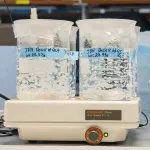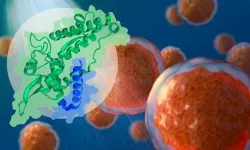(Press-News.org) Higher BMI is significantly associated with worse mental health, especially in women, per study of middle-aged and older adults which adjusted for lifestyle and demographic factors
###
Article URL: https://journals.plos.org/plosone/article?id=10.1371/journal.pone.0299029
Article Title: Associations between adiposity measures and depression and well-being scores: A cross-sectional analysis of middle- to older-aged adults
Author Countries: Ireland
Funding: This research was funded by the Irish Health Research Board, grant number: HRC/2007/13. The funder had no role in the study design, data collection and analysis, decision to publish or preparation of the manuscript.
END
Higher BMI is significantly associated with worse mental health, especially in women, per study of middle-aged and older adults which adjusted for lifestyle and demographic factors
2024-03-06
ELSE PRESS RELEASES FROM THIS DATE:
This injectable hydrogel mitigates damage to the right ventricle of the heart
2024-03-06
An injectable hydrogel can mitigate damage to the right ventricle of the heart with chronic pressure overload, according to a new study published March 6 in Journal of the American College of Cardiology: Basic to Translational Science.
The study, by a research team from the University of California San Diego, Georgia Institute of Technology and Emory University, was conducted in rodents. In 2019, this same hydrogel was shown to be safe in humans through an FDA-approved Phase 1 trial in people who suffered a heart attack. As a result of the new preclinical ...
Giant dinosaur was “heron from hell,” not a deep diver, says new analysis
2024-03-06
For years, controversy has swirled around how a Cretaceous-era, sail-backed dinosaur—the giant Spinosaurus aegyptiacus—hunted its prey. Spinosaurus was among the largest predators ever to prowl the Earth and one of the most adapted to water, but was it an aquatic denizen of the seas, diving deep to chase down its meals, or a semiaquatic wader that snatched prey from the shallows close to shore?
A new analysis led by paleontologists from the University of Chicago reexamines the density ...
New deep-sea worm discovered at methane seep off Costa Rica
2024-03-06
Greg Rouse, a marine biologist at UC San Diego’s Scripps Institution of Oceanography, and other researchers have discovered a new species of deep-sea worm living near a methane seep some 50 kilometers (30 miles) off the Pacific coast of Costa Rica. Rouse, curator of the Scripps Benthic Invertebrate Collection, co-authored a study describing the new species in the journal PLOS ONE that was published on March 6.
The worm, named Pectinereis strickrotti, has an elongated body that is flanked by a row of feathery, gill-tipped appendages called ...
Nanosurgical tool could be key to cancer breakthrough
2024-03-06
The high-tech double-barrel nanopipette, developed by University of Leeds scientists, and applied to the global medical challenge of cancer, has - for the first time - enabled researchers to see how individual living cancer cells react to treatment and change over time – providing vital understanding that could help doctors develop more effective cancer medication.
The tool has two nanoscopic needles, meaning it can simultaneously inject and extract a sample from the same cell, expanding its potential uses. And the platform’s high level of semi-automation has sped ...
Genetic mutation in a quarter of all Labradors hard-wires them for obesity
2024-03-06
New research finds around a quarter of Labrador retriever dogs face a double-whammy of feeling hungry all the time and burning fewer calories due to a genetic mutation.
This obesity-driving combination means that dog owners must be particularly strict with feeding and exercising their Labradors to keep them slim.
The mutation is in a gene called POMC, which plays a critical role in hunger and energy use.
Around 25% of Labradors and 66% of flatcoated retriever dogs have the POMC mutation, which researchers previously showed causes increased interest in food ...
MIT scientists use a new type of nanoparticle to make vaccines more powerful
2024-03-06
CAMBRIDGE, MA -- Many vaccines, including vaccines for hepatitis B and whooping cough, consist of fragments of viral or bacterial proteins. These vaccines often include other molecules called adjuvants, which help to boost the immune system’s response to the protein.
Most of these adjuvants consist of aluminum salts or other molecules that provoke a nonspecific immune response. A team of MIT researchers has now shown that a type of nanoparticle called a metal organic framework (MOF) can also provoke a strong immune response, by activating the innate immune system — the body’s first line of defense against ...
A noninvasive treatment for “chemo brain”
2024-03-06
CAMBRIDGE, MA -- Patients undergoing chemotherapy often experience cognitive effects such as memory impairment and difficulty concentrating — a condition commonly known as “chemo brain.”
MIT researchers have now shown that a noninvasive treatment that stimulates gamma frequency brain waves may hold promise for treating chemo brain. In a study of mice, they found that daily exposure to light and sound with a frequency of 40 hertz protected brain cells from chemotherapy-induced damage. The treatment also helped to prevent memory loss and impairment of other ...
Film festivals are becoming more diverse in several ways, new study reports
2024-03-06
A group of Tallinn University researchers has published an innovative study that sheds light on the intricate dynamics of the global film festival circuit, revealing insights into diversity and public value creation within the industry. The research demonstrates that festival programming has become more thematically diverse, and the inclusion of films by women creatives has increased between 2012–2021.
The study “Quantifying the global film festival circuit: Networks, diversity, and public value creation,” published open access in the PLOS ONE journal, provides a comprehensive analysis of over 600 film festivals worldwide, spanning a period ...
New hydrogen producing method is simpler and safer
2024-03-06
Researchers in Sweden unveiled a new concept for producing hydrogen energy more efficiently, splitting water into oxygen and hydrogen without the dangerous risk of mixing the two gases.
Developed at KTH Royal Institute of Technology in Stockholm, the new method decouples the standard electrolysis process for producing hydrogen gas, which splits water molecules by applying an electric current. In contrast with prevailing systems it produces the resulting oxygen and hydrogen gases separately rather than simultaneously in the same cell, where they need to be separated by membrane barriers
That separation eliminates the possibility of the gases mixing with the risk of explosions, says ...
Studying the relationship between cancer-promoting proteins
2024-03-06
By Simonne Griffith-Jones, Predoctoral Fellow, EMBL Grenoble
Researchers from the Bhogaraju Group at EMBL Grenoble have gained new insights into how a cancer-relevant family of proteins bind their targets. The results of the study, published in The EMBO Journal, could potentially help in the development of drugs against certain chemotherapy- and radiotherapy-resistant cancers.
The Melanoma Antigen Gene (MAGE) family consists of more than 40 proteins in humans, most of which are only present in the ...










